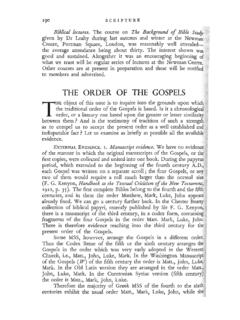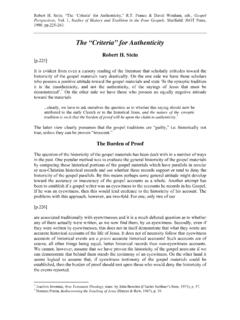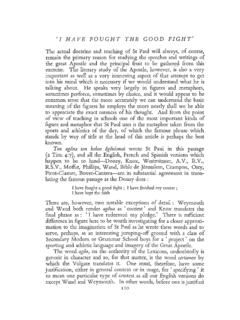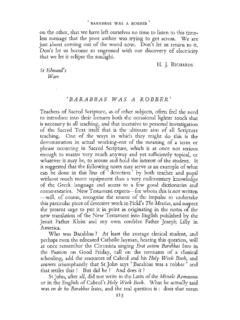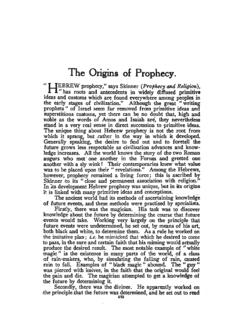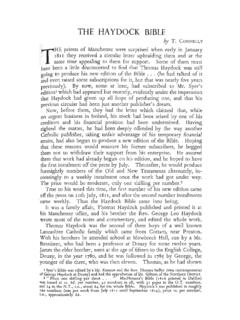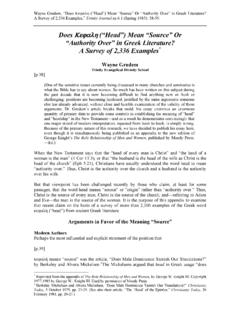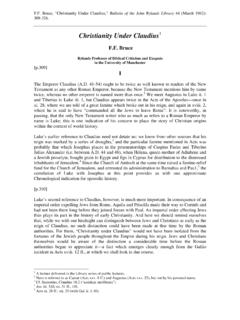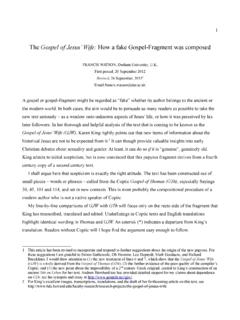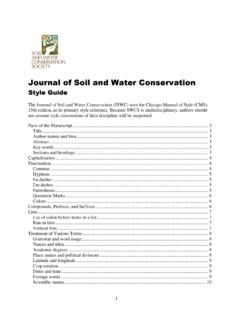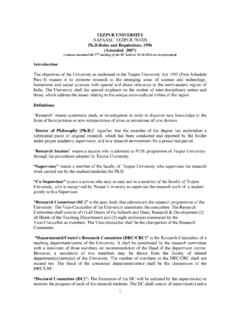Transcription of PAUL'S CONVERSION/CALL: A COMPARATIVE …
1 JBL 10013 (]981) 415-432 PAUL'S conversion / call : A COMPARATIVE analysis OF THE three REPORTS IN ACTS CHARLES W. HEDRICK SOUTHWEST MISSOURI STATE UNIVERSITY. SPRINGFIELD. MO 65802 JOHANNES Munck has described the three accounts of PAUL'S "con-version" in Acts (9:1-19; 22:4-16 [with 22:17-211; 26:12-18) as call /commissioning narratives modeled on the order of OT prophetic call /commissioning narratives.! He argues that, in spite of obvious differences that most modern scholars recognize among the reports,2 when "we approach what is essential in the account [of PAUL'S conver-sion] , namely its nature and meaning, the greater becomes the agreement.
2 "3 For Munck, the similarity in motif among all three allows one to argue that "the accounts in Acts go back to Paul, as. they show a close connexion with Galatians."4 The similarity that Munck notes among the three passages in Acts, he also finds in PAUL'S own statement .in Gal 1: 15, namely that they understand PAUL'S experience in terms of the calls of Isaiah and Jeremiah. Yet, the specific motif in Gal 1:15 ("set me apart before I was born"), which Munck correctly associates with Isa 49:1-6 and Jer' 1 :4-5, does not appear in the narratives in Acts.
3 Munck's thesis that all three accounts in Acts are modeled on OT call narratives is not convincing, although it is obvious that all three do share call /commissioning features. The general call /commissioning motifs, to which Munck points, seem an insufficient basis on which to argue that the Acts accounts "go back to Paul." A simpler and more reasonable explanation is that Luke was responsible for stylizing the narratives in Acts along the lines of OT call narratives. In short, Munck has not proven his thesis that "in all four accounts, PAUL'S call was related [ , narrated] in the same way as the call of the OT characters in the history of Salvation,"5 though he is quite right that all accounts do reflect call /commissioning motifs.
4 Martin Dibelius, on the other I J. Munck, Paul and the Salvation of Mankind (Atlanta: John Knox, 1959) 24-35. 2 Ibid., 16-20. 3 Ibid., 24. 4 Ibid., 29. 51. Munck, The Acts of the Aposi/es (AB 31; Garden City: Doubleday, 1967) 82. 41(j JOURNAL OF BIBLICAL LITERATURE hand, has attributed the differences in the accounts to the hand of Dibelius, however, did not work out in detail the literary solu~ tion to the problems of similarity/dissimilarity in the three accounts of Acts, as he did with the three accounts of the conversion of Cornelius and the two accounts of the vision of Peter (Acts 10:1-11:18).)
5 1 He was content with disproving the argument that the similarities and differ~ ences in the three accounts of PAUL'S " conversion " were to be attributed to different There have been other attempts to define differently the form . critical classification of the narratives of PAUL'S conversion / call . As early as 1932, Hans Windisch and others had noted the similarity in structure between PAUL'S conversion in Acts and the Heliodorus legend in 2 Maccabees 3 and other Hellenistic Recently Gerhard Lohfink has analyzed the Christophany in Acts 9:4-6, 22:7-10, 26:14-15 as an Erscheinungsgespriich, or a discourse in connection with a heavenly appearance, that Lohfink has found elsewhere only in the Elohistic tradition of the Pentateuch.
6 On the basis of Luke's dependence upon the Septuagint in the book of Acts and the fact that the same form appears . in the story of the conversion of Cornelius in Acts, Lohfink believes that Luke composed the narratives of PAUL'S Christoph Burchard has discussed the similarities in form and content between these parallels and the account of PAUL'S conversion / call in Acts 9, as well as pointing out its similarities to the Jewish~ Hellenistic novel Joseph and It does not appear, however, that a detailed COMPARATIVE analysis of the structure of the three narratives in Acts has yet been made from the perspective of Luke's literary methodY Examined on this; basis it 6M.
7 Dibelius, Studies in the Acts oj the Apostles (London: SCM, 1956) 158 n. 47. See also the brief discussion by E. Haenchen, oj the Apostles: A Commentary (Philadel-phia: Westminster, 1971) 107-10 and H. J. Cadbury, The Making oj Luke-Acts (London: S. P. C. K. 1968) 213-38. 7 Dibelius, Studies in Acts, ,14, 94-95, 109-22. 8 Ibid., 177. 9H. Windisch, "Die Christusepiphanie vor Damascus (Act 9, 22 und 26) und ihre religionsgeschichtlichen Parallelen," ZNW 31 (1962) h-23. lOG. Lohfink, "Eine alttestamentliche Darstellungsform fUr Gotteserscheinungen in den Damaskusberichten (Apg 9; 22; 26)," BZ 9 (1965) 246-57.
8 Not all have been con-vinced by his evidence; see O. H. Steck, "Formgeschichtliche Bemerkungen zurDar-stellung des Damaskusgeschehens in der Apostelgeschichte," ZNW 67 (1976) 20-28 and C. Burchard, Der dreizehnte Zeuge: Traditions-und kompositionsgeschichtliche Untersuchungen zu Lukas' Darste/lung der Friizeit des Paulus (Gottingen: Vandenhoeck & Ruprecht, 1970) 54-55. See also Lohfink's The conversion oj St. Paul (Chicago: Franciscan Herald, 1976) 61-85. IIBurchard, Der dreizehnte Zeuge, 54-105. (2 But compare Burchard's discussion, Der dreizehnte Zeuge, 105-36.)
9 See also the dis-cussion by B. J. Hubbard, "The Role of Commissioning Accounts in Acts," Perspectives on HEDRICK: PAUL'S conversion / call 417 appears that Acts 9:1-19, Acts 22:4-16 and Acts 26:12-18 are in form three different narratives. While they share similar motifs and purport to describe the same incident, they utilize different literary modes. Acts 9: 1-19 is basically a miracle story of the healing of PAUL'S blindness. Acts 22:4-16 appears to be a healing narrative that has been redacted into a commissioning narrative; Acts 26:12-18 is a commissioning narrative.
10 I. A Parallel Synopsis of the Structure of the three Narratives Acts 9 has arbitrarily been selected as the control narrative against which the structure of the other two narratives will be compared. Motif Acts 9: Acts 22: Acts 26: (1) . Letters to the 1-2 4-5 (Letters to the 12b (Authority & synagogues from brethren from high commission of chief the high priest. priest and elders.) priests but omits recipients.) . (2) He approached 3a 6a 12a Damascus. (3) A light from 3b 6b (About noon a 13 (At midday, I heaven flashed great light shone saw a great light around him.))
